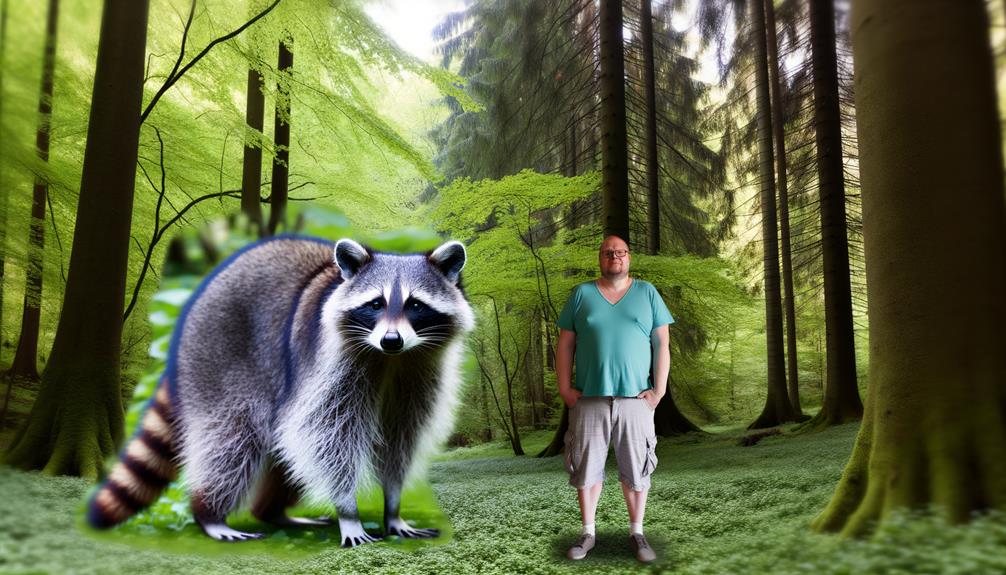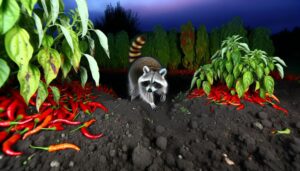How to Measure Raccoon Growth: Understanding How Big They Get
Raccoons typically weigh between 8 to 20 pounds and measure 16 to 28 inches in length. Males are generally larger, and raccoons in northern habitats tend to be bigger for thermoregulation.
Urban raccoons often experience enhanced growth due to abundant food sources, occasionally boosting their weight by 20% over their wild counterparts. Exceptional cases have documented raccoons exceeding 50 pounds, attributed to favorable genetics and consistent urban food supplies.
Seasonal variations also impact their size, with weight increasing during autumn for winter survival. Understanding these aspects is essential for effective wildlife management.
To explore more on this intriguing topic, continue on.

Key Takeaways
- Adult raccoons typically weigh between 8 to 20 pounds and measure 16 to 28 inches in body length.
- Males are generally larger than females, with northern raccoons being notably bigger.
- Urban raccoons can weigh up to 20% more than their wild counterparts due to abundant food sources.
- Record-breaking raccoons can weigh over 50 pounds, influenced by genetics and consistent nutrition.
- Seasonal size variations occur, with raccoons gaining weight in autumn and losing it during winter scarcity.
Average Raccoon Size
On average, adult raccoons (Procyon lotor) typically weigh between 8 to 20 pounds (3.6 to 9 kg) and measure approximately 16 to 28 inches (40 to 70 cm) in body length, excluding their tail. These measurements reflect the typical size range observed in wild populations, where environmental factors and food availability play critical roles.
Morphometric studies have consistently indicated that males generally exhibit slightly larger dimensions compared to females. Additionally, biogeographic data suggest a marginal variation in size across different regions, with raccoons in northern habitats tending to be larger, likely due to adaptive mechanisms for thermoregulation.
Understanding these metrics can aid wildlife rehabilitators, veterinarians, and conservationists in making informed decisions regarding health assessments, habitat management, and population control efforts.
Factors Influencing Growth
Several intrinsic and extrinsic factors collectively influence the growth patterns of raccoons, including genetics, diet, habitat conditions, and seasonal variations. Genetic predispositions primarily dictate potential size, while diet quality and availability significantly affect actual growth. Habitat conditions, such as shelter and climate, further modulate growth rates. Seasonal variations, particularly in food availability, induce cyclical growth patterns.
| Factor | Impact on Growth | Emotional Response |
|---|---|---|
| Genetics | Fixed growth potential | Fascination |
| Diet | Variable growth realization | Concern for well-being |
| Habitat Conditions | Modulates growth rates | Appreciation of nature |
Understanding these factors is vital for wildlife management and conservation efforts, ensuring raccoons thrive in diverse environments.
Urban Vs. Wild Raccoons
Contrary to their wild counterparts, urban raccoons exhibit notable differences in behavior, diet, and growth rates due to the unique pressures and resources available in metropolitan environments.
Urban raccoons benefit from an abundant and consistent food supply, primarily consisting of human waste and pet food, contributing to increased body mass. Studies indicate urban raccoons can weigh up to 20% more than wild raccoons. Additionally, urban environments offer fewer natural predators, allowing for longer lifespans and larger growth potential.
Behavioral adaptations include increased nocturnality and familiarity with human activity, enhancing their survival in cities. This convergence of factors results in urban raccoons often being more robust and larger compared to their wild counterparts, reflecting their adaptability to urbanized ecosystems.
Record-Breaking Raccoons
Examining the upper limits of raccoon size, documented cases reveal individuals reaching weights in excess of 50 pounds, surpassing the average raccoon weight of 10-20 pounds by a substantial margin. This noteworthy deviation highlights the potential for extreme growth under particular conditions. Scientific analysis of these outliers provides insight into the factors contributing to such considerable weight gain.
- Genetic predisposition: Certain raccoons may possess genetic traits that favor larger body mass.
- Nutritional intake: Access to abundant and high-calorie food sources can notably increase weight.
- Environmental factors: Urban settings often provide more consistent food supplies and fewer predators, enabling larger sizes.
Understanding these parameters can inform wildlife management practices and support efforts to maintain ecological balance.
Seasonal Size Variations
In addition to genetic, nutritional, and environmental influences, raccoon size undergoes notable seasonal variations due to changes in food availability and metabolic demands. During autumn, raccoons accumulate fat reserves, reaching peak weights to prepare for winter scarcity. Conversely, winter sees a decline in body mass due to reduced food intake and increased metabolic expenditure for thermoregulation. Spring and summer offer abundant resources, facilitating growth and weight gain.
| Season | Average Weight (kg) | Key Factors |
|---|---|---|
| Spring | 7-9 | Abundant food, breeding |
| Summer | 8-11 | Peak resource availability |
| Autumn | 10-14 | Fat accumulation |
| Winter | 6-8 | Food scarcity, high metabolism |
This cyclical weight fluctuation underscores the raccoon's adaptive strategies for survival.
Raccoon Growth Stages
How do raccoons progress through their distinct growth stages from neonates to fully mature adults?
Raccoons (Procyon lotor) undergo several developmental phases marked by significant physiological and behavioral changes. Initially, neonates are altricial, weighing approximately 75-100 grams and dependent on maternal care.
By eight weeks, juveniles begin weaning and exhibit increased mobility and foraging behaviors.
At six months, subadults attain approximately 50-75% of their adult size, engaging in more complex social interactions.
Full maturity is typically reached by 12 months, with adults weighing between 4.5-15 kg, depending on environmental conditions and resource availability.
Conclusion
To sum up, raccoon size is influenced by various factors including genetics, diet, and environment, with urban raccoons often growing larger due to increased food availability.
Seasonal variations also play a role, with raccoons tending to gain weight in preparation for winter.
Record-breaking individuals demonstrate the species' potential for significant growth.
As the adage goes, 'You are what you eat,' and the data supports that raccoon size is largely contingent on access to nutritional resources.






